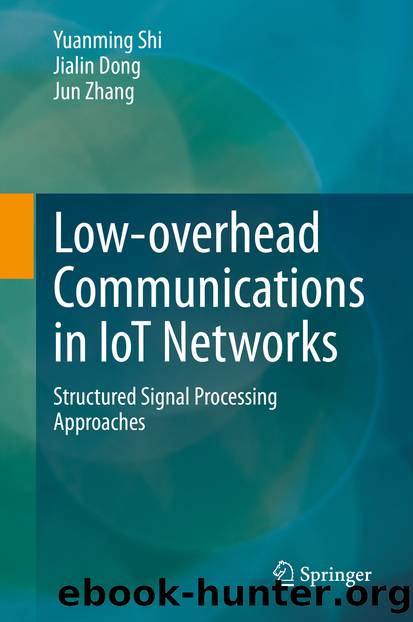Low-overhead Communications in IoT Networks by Yuanming Shi & Jialin Dong & Jun Zhang

Author:Yuanming Shi & Jialin Dong & Jun Zhang
Language: eng
Format: epub
ISBN: 9789811538704
Publisher: Springer Singapore
where λ 1 ≥ 0 and λ 2 ≥ 0 are the regularization parameters. The group sparsity structure in the aggregated data signals x induces a group sparsity structure in the lifting vector
where vec(M) is the vectorization of matrix M. Furthermore, the ℓ 1∕ℓ 2-norm is adopted to induce the group sparsity in the vector vec(W), i.e.,
4.4 Difference-of-Convex-Functions (DC) Programming Approach
Although the convex relaxation approach (4.8) provides a natural way to solve problem (4.6), the results obtained from norm relaxation are usually suboptimal to the original nonconvex optimization problem [10]. Moreover, two regularization parameters are introduced by the combination of norms, which are difficult to tune. Additionally, there is no efficient convex relaxation approach to simultaneously induce low-rankness and sparsity [2]. To address these issues, the paper [6] developed a difference-of-convex-functions (DC) representation for the rank function in order to satisfy the fixed-rank constraint.
In the sequel, we consider the sparse blind demixing model under the multiple-antenna BS scenario. Specifically, the sparse blind demixing problem is reformulated as a sparse and low-rank matrix recovery problem via lifting the bilinear model into the linear model. Based on the linear model, an exact DC formulation for the rank constraint is further established, followed by developing an efficient DC algorithm (DCA) for minimizing the DC objective.
Download
This site does not store any files on its server. We only index and link to content provided by other sites. Please contact the content providers to delete copyright contents if any and email us, we'll remove relevant links or contents immediately.
Algorithms of the Intelligent Web by Haralambos Marmanis;Dmitry Babenko(16235)
Jquery UI in Action : Master the concepts Of Jquery UI: A Step By Step Approach by ANMOL GOYAL(9387)
Test-Driven Development with Java by Alan Mellor(7735)
Data Augmentation with Python by Duc Haba(7609)
Principles of Data Fabric by Sonia Mezzetta(7378)
Learn Blender Simulations the Right Way by Stephen Pearson(7294)
Microservices with Spring Boot 3 and Spring Cloud by Magnus Larsson(7137)
Hadoop in Practice by Alex Holmes(6587)
RPA Solution Architect's Handbook by Sachin Sahgal(6516)
The Infinite Retina by Robert Scoble Irena Cronin(6216)
Big Data Analysis with Python by Ivan Marin(5934)
Life 3.0: Being Human in the Age of Artificial Intelligence by Tegmark Max(5516)
Pretrain Vision and Large Language Models in Python by Emily Webber(4894)
Infrastructure as Code for Beginners by Russ McKendrick(4653)
Functional Programming in JavaScript by Mantyla Dan(4436)
WordPress Plugin Development Cookbook by Yannick Lefebvre(4382)
The Age of Surveillance Capitalism by Shoshana Zuboff(4245)
Embracing Microservices Design by Ovais Mehboob Ahmed Khan Nabil Siddiqui and Timothy Oleson(4148)
Applied Machine Learning for Healthcare and Life Sciences Using AWS by Ujjwal Ratan(4135)
